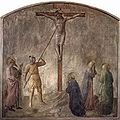 At a talk with a group of young adults, someone asked about the history of the Stations of the Cross and I did not have an answer! I certainly pray the Stations of the Cross and when I go into a church for the first time, I like to take a look at that Church’s stations because there are such a wide variety of styles. When I was a student in Rome, one of my most memorable experiences was praying the Stations of the Cross at the Roman Coliseum on Good Friday with Pope John Paul II. Pope John Paul had the practice of inviting different groups of people to write the reflections to accompany the stations. The year I participated, he had invited Catholic journalists to be the writers. One of my housemates who wrote for a German Catholic newspaper was chosen as a writer. For all of the discussions we had about the Stations of the Cross as we helped her prepare, you would think I would have learned something about their origin.
At a talk with a group of young adults, someone asked about the history of the Stations of the Cross and I did not have an answer! I certainly pray the Stations of the Cross and when I go into a church for the first time, I like to take a look at that Church’s stations because there are such a wide variety of styles. When I was a student in Rome, one of my most memorable experiences was praying the Stations of the Cross at the Roman Coliseum on Good Friday with Pope John Paul II. Pope John Paul had the practice of inviting different groups of people to write the reflections to accompany the stations. The year I participated, he had invited Catholic journalists to be the writers. One of my housemates who wrote for a German Catholic newspaper was chosen as a writer. For all of the discussions we had about the Stations of the Cross as we helped her prepare, you would think I would have learned something about their origin.
A Long Tradition
The tradition dates back to the 11th century when it became popular for Christians to make pilgrimages to the Holy Land. In fact, one of the oldest accounts of a Holy Landpilgrimage is written by A Spanish woman named Egeria. These pilgrims desired to walk in the footsteps of Jesus, particularly, the path of his crucifixion and death (Via Crucis). During the 12th and 13th centuries when it became unsafe to travel to the Holy Land, many churches throughout Europe created an outdoor devotion with stations that depicted the life of Jesus. These stations numbered as few as five and as many as twenty. As the devotion grew in popularity, Pope Clement XII (1730-1740) set the number at 14. It wasn’t until the 18th century that churches began to place the stations on the inside walls. Some of you who are very observant will note that many churches have added a 15th station for the resurrection.
Praying the Stations of the Cross
Friday is the traditional day to pray the Stations—in memory of Jesus’ death, however they can be prayed at any time. This Lent, Archbishop Wuerl, in his recording of the Stations has made it possible to pray at your desk or in your home. See http://www.adw.org/parishes/pdf/09Lent_stations.pdf. For a written resource see www.usccb.org/nab/stations.shtml

thanks for the information. I took the remaining Catholic Standards from my church to use during lent, all of the pictures were printed in color. Very good tool to use for children and young adults. I don’t believe we have the fifteenth station, must I must check.
I remember that when I was a child in the 50s, the Stations of the Cross always ended with Christ’s being buried in the tomb, and we all went home very sad, and remained that way for all of Lent.
Now, as an adult, when we attend the Stations, they always end with the Resurrection, and we all go home happy, knowing “the rest of the story”, that is, that Jesus did rise again.
When did this shift in focus occur? What used to be an incredibly somber season, that is Lent, we now focus on the Resurrection for the entire 40 days. Again, when exactly did this shift occur?
Many thanks, and Peace.
Michele,
Good Question. Indeed following the second Vatican Council (1962-1965) there was a new emphasis that focused on “remembering” in a more spiritual sense–that is that we don’t move through Lent pretending that we don’t know the rest of the story–but rather we use the resurrection to help us focus in a deeper way on the meaning of our Lord’s passion. In the Gospel of John that will be the first reading on Palm Sunday, the disciples say they did not understand the meaning if Jesus’ entry into Jerusalem until after the ressurection. Much like we don’t “count” Sundays as days of Lent because we celebrate the fullness of Jesus’ life death and resurrection in the Eucharist, we pray the Stations of the Cross, with the exception of Good Friday with the “end of the story” included. We can’t ever forget that we have been saved. I think Lent ought to be serious and somber in our intention. I hope this helps.
Susan
Kinship: it`s all relative!
Amen!